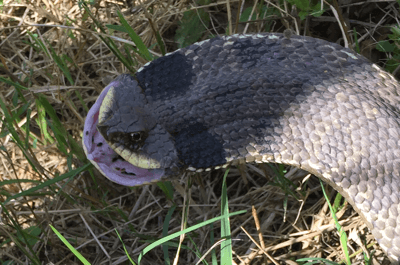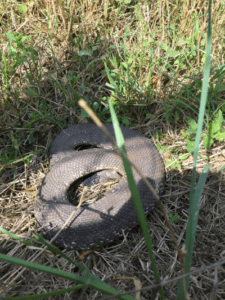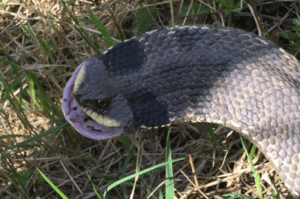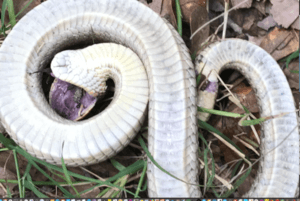The Harmless Hognose Snake
Many people are deathly afraid of snakes, and I don’t mean cobras or pythons, or rattlesnakes. They shriek or scurry off in terror at the sight of garter snakes, brown snakes, water snakes, and yes, even the harmless hognose snake.
There may not be a snake as harmless as the hognose snake. It almost never bites, though when first approached, it may feign an attack. Typically, it will curl up hoping you will go away, then it may pretend to attack. When all else fails, it will pretend to be dead. Juveniles (usually) will forego the first two bluffs and play dead immediately. I’ve included a series of photos taken by my son when he came across one of the harmless hognose snakes recently.
harmless hognose
feigning attack
playing dead
As you can see above, the snake first attempts to “hide” by curling up and hoping you don’t see it. If a person were to walk away at that time, the snake would quickly slither off.

Assuming the person doesn’t walk away, the hognose will pretend to be aggressive and will bluff a ferocious attack, usually hissing as it pretends it will strike.

When that fails, the hognose will resort to playing dead, and it puts on a command performance. It will roll onto its back and often stick out its tongue as if dead. It remains motionless even if you touch it.
I have heard some people call the harmless hognose snake venomous, but that isn’t entirely true. Hognose snakes may technically be venomous because their saliva contains enough sedative to affect small animals such as toads, lizards, and others, but it definitely doesn’t have enough to bother a human. Besides that, a hognose rarely bites anything other than what it is eating.
How to Identify a Harmless Hognose Snake
Hognose snakes are easily misidentified. There are a variety of hognose (a dozen or more), and they can be found in a variety of colors and sizes. You can read more about them [here].
One distinguishing feature that they all share is an upturned nose. They may or may not display aggressiveness upon first meeting them. Some will puff up and hiss, some will flatten their head on the ground to appear larger, some will pretend to strike (though they always seem to fall short of their mark), and some will simply roll over and play dead immediately. Hognose snakes have been known to play dead for as long as fifteen minutes.
Are Hognose Snakes Dangerous?
No, they are not dangerous unless you are a rodent, toad, lizard, etc. Their diet consists of mainly those animals. Hognose snakes may appear to be dangerous, and if you listen to tales told by a lot of people, they would seem to be very dangerous, but they’re not. In many parts of the Southern United States, they are referred to as puff adders, but they are no such thing.
Puff adders are a venomous snake, but they are only native to Africa and the Southern Arabian Peninsula. They are not found in the United States (unless they’ve been imported).
The Bottom Line
If you’re out and about and happen to come across a hognose snake, please don’t kill it. And don’t be frightened. Simply walk the other way and all will be fine. You and the snake will both feel better. For some statistics on what will really harm you, check out [this post.]
If You Enjoyed This Post, Please Share.
Giacomo Giammatteo is the author of gritty crime dramas about murder, mystery, and family. And he also writes nonfiction books including the No Mistakes Careers series as well as books about grammar, publishing., and children’s fiction and nonfiction.
When Giacomo isn’t writing, he’s helping his wife take care of the animals on their sanctuary. At last count, they had forty animals—seven dogs, one horse, six cats, and twenty-five pigs.
Oh, and one crazy—and very large—wild boar, who used to take walks with Giacomo every day.
He lives in Texas where he and his wife have an animal sanctuary with forty loving “friends.”





